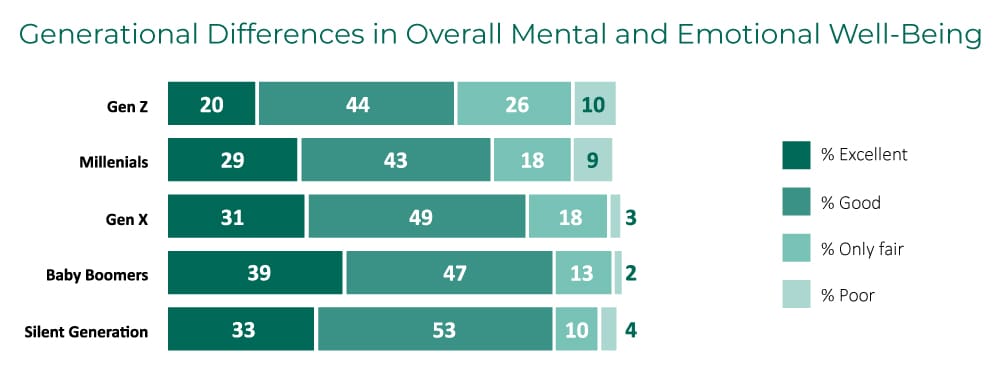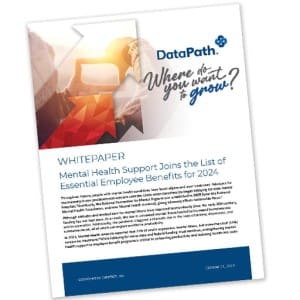Throughout history, people with mental health conditions have faced stigma and poor treatment. Advocacy for the mentally ill was practically non-existent until the 1840s when Dorothea Dix began lobbying for state mental hospitals. Eventually, the National Committee for Mental Hygiene was established in 1909 (later the National Mental Health Association, and now Mental Health America), giving advocacy efforts nationwide focus.
Although attitudes and medical care for mental illness have improved tremendously since the early 20th century, funding has not kept pace. As a result, the rise in untreated mental illness has led to increased homelessness and incarceration. Additionally, the pandemic triggered a dramatic rise in the rates of anxiety, depression, and substance abuse, all of which can impact workforce productivity.
In 2023, Mental Health America reported that 21% of adults experience mental illness, but more than half (55%) receive no treatment. While lobbying for more state and federal funding must continue, strengthening mental health support in employee benefit programs is critical to enhancing productivity and reducing healthcare costs.
History of Workplace Wellness and Mental Health Benefits
The first Employee Assistance Programs, or EAPs, emerged from occupational alcoholism programs in the 1940s. These had been set up to address widespread alcohol abuse among returning World War II veterans. By the 1950s, EAPs expanded to improve employee productivity by addressing “people problems” and issues like smoking and occupational injuries.
In the 1960s, workplace wellness focused on occupational safety as the number and severity of work-related illnesses and injuries rose (ultimately leading to creation of the Occupational Safety and Health Administration, or OSHA, in 1971).
That focus shifted to smoking cessation and physical fitness in the 1970s as the financial responsibility for healthcare shifted from the government to employers. Passage of the Employee Retirement Income Security Act (ERISA) in 1974 mandated that employers provide workers with more information on employee benefit plans.
Wellness programs in the 1980s expanded to address psychological well-being and work-life balance. In 1984, OSHA started encouraging employers to implement stress-related mental health programs in the workplace. The National Institute of Mental Health (NIMH) launched the “Depression/Awareness, Recognition, and Treatment” initiative (DART) in 1988 to teach medical professionals, employers, and the public to reject stigma and recognize depression as a medical disorder.
The last decade of the 20th century saw the creation of the NIMH’s “Managing Depression in the Workplace” program in 1991. Workplace wellness initiatives focused on awareness and emphasized lifestyle and behavioral changes.
By the turn of the millennium, workplace wellness programs had become widespread throughout the U.S. and the spotlight turned to becoming more comprehensive. Points of focus included awareness, prevention, mental and emotional health, and financial security.
The U.S. Dept. of Health and Human Services (HHS) released “Healthy People 2010,” encouraging companies with at least 50 employees to pursue health screenings, healthcare education, and supportive physical and social workplace environments.
As the 2020s unfold, mental and behavioral health have become an essential part of employee healthcare, including the rise in many companies of what are often referred to as “well-being teams.” Demand for EAPs has outpaced available providers. There is a shift in thinking towards treating alcohol and drug abuse as chronic medical conditions. Wellness coaches work to help companies reduce costs by improving worker health – mental as well as physical.
Employee Mental Health Demand Grows
As society has grown more educated about and supportive of mental and emotional health needs, demand for related workplace benefits has increased.
During the pandemic, from March 2020 to August 2022, spending on mental health by Americans with employer-provided insurance grew by 53%, according to a study by the RAND Corporation and Castlight Health. Use of mental telehealth services increased roughly tenfold. Overall, by August 2022, utilization of mental health services was nearly 39% higher than before the pandemic.
In their 2023 Workplace Mental Health Trends Report, Calm Business found that 67% of employees want their employers to help them handle stress and anxiety. According to the American Psychological Association, over 80% of workers seek employers who care about their mental health.
More than a fourth (28%) of workers in a 2022 JobSage survey cited mental health issues as the biggest reason they left their jobs. The reasons cited included burnout, stress, depression, lack of motivation, anxiety, and anger.
Finally, the ADP Research Institute found that more than half (53%) of workers believe their work suffers because of poor mental health.
Prioritizing Mental Health Benefits for 2024
Employees have proven they will access mental health benefits when such benefits are available. Nearly nine in 10 (86%) employees employees with mental health benefits use them. The most common utilization is for online therapy (57%), followed by emotional support lines (55%) and in-person therapy (50%).
But 20% of workers of workers say their employer does not do enough to support their mental health. And according to the Buck consulting firm, just 51% of employees feel their employer is more focused on their total wellbeing than before –
despite 68% of employers saying they have enhanced their wellbeing proposition.
To stay competitive, support productivity, and attract and retain talent, employers must prioritize mental health benefits in 2024 and beyond. Otherwise, they risk employees fleeing to other companies that might better support their needs. Consider these recent findings:

What Resources Can TPAs and Brokers Use to Help Employers Meet Employee Mental Health Needs?
Health Insurance, including EAPs
Sixty-three percent of employers surveyed by the Business Group on Health plan to work with their health plan and other vendors to expand mental health access.
Tax-Advantaged Healthcare Spending Accounts (FSA, HSA, HRA)
These accounts help bridge the healthcare deductible gap and cover copays and coinsurance for counseling and therapy services, psychiatric care, addiction treatment, prescription medications, acupuncture, hypnosis, and more.
Lifestyle Spending Accounts (LSA)
Nearly 8 in 10 (77%) employers say they will focus on improving mental health access in 2024.20 The most popular methods cited include online resources, such as apps, articles, and webinars. Employers can promote such initiatives in part by making these expenses eligible for LSA reimbursement.
Additionally, LSAs can be used to support related mental and emotional well-being expenses such as yoga and meditation classes, meal delivery service fees, recreational sports fees, and entertainment tickets.
Student Loan Repayment Assistance (SLRA)
Student loan debt is one of the major causes of financial stress. Thanks to legislation passed in 2021, employers can contribute up to $5,250 annually per employee in non-taxable student loan payment assistance through 2025.
Emergency Savings Accounts
Many Americans realized during the pandemic that they were just one emergency away from a financial crisis. Post-pandemic inflationary pressures and rising interest rates have delayed recovery. Employers can make it easier for workers to set aside emergency funds by providing automatic partial payroll diversion into employee savings accounts.

